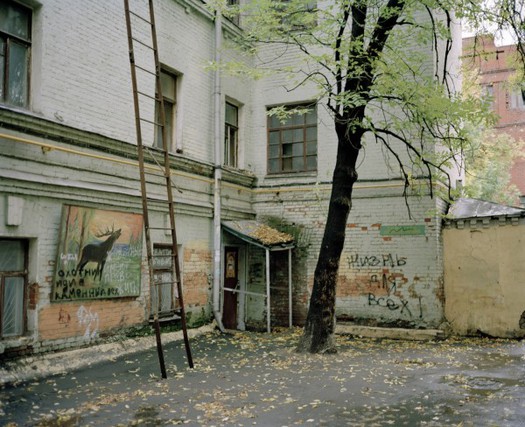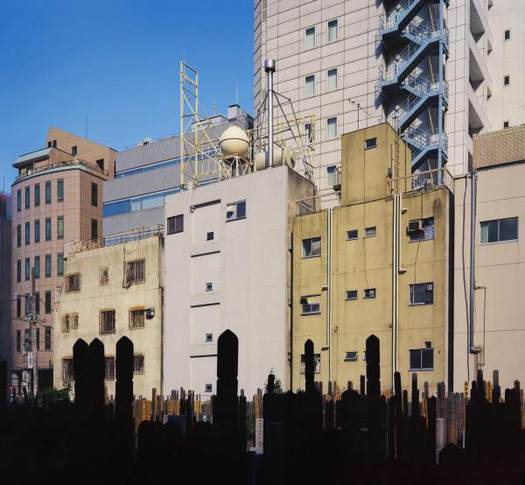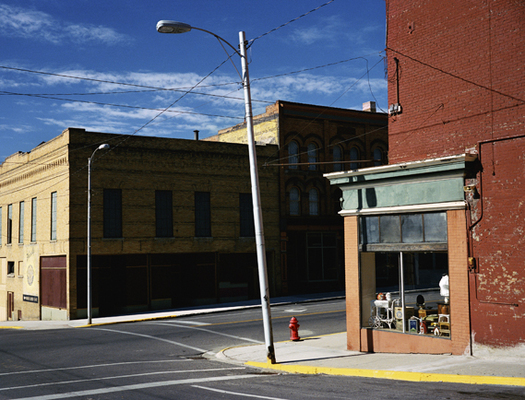
Wim Wenders, Moscow Back Yard, C-print, 2006
The German film director Wim Wenders’ latest exhibition of photographs has an irresistible title — Places, strange and quiet — but I still went along with mixed feelings. In my 20s, I counted films such as Alice in the Cities, Kings of the Road and The American Friend among my favorites. Wenders was the European maestro of the road movie, his postwar generation’s consciousness colonized, as he would often remind us, by American culture. In 1986, at the Pompidou Center in Paris, I saw Wenders’ first exhibition of photographs, Written in the West, American street scenes shot while scouting locations for Paris, Texas, and adored it.
Now I’m better acquainted with the street photographs of color picture pioneers like Stephen Shore and William Eggleston, Wenders’ photos, published as a book in 1987, don’t look quite so special, though his loving shots of run-down movie theaters in Arizona, boarded-up cafes in New Mexico and deserted street corners in Texas retain their interest as documents of what might by now be lost (or renovated) buildings. When the sun pours down like honey, even economic inertia and squalor can look ravishing and cherishable. Meanwhile, and more significantly, Wenders appeared to lose his way as a film-maker, as even the director himself was prepared to acknowledge. It no longer felt as pressing to keep up with his latest projects.
But career comebacks do happen and Wenders’ 3D documentary about the distinguished German choreographer Pina Bausch has been gaining some rapt reviews. The arrival of Places, strange and quiet in the palatial setting of the Haunch of Venison gallery in London, a space once occupied by the Museum of Mankind, adds to the sense that Wenders is experiencing what Sight & Sound magazine calls, in its latest issue, a “third coming.” 
Wim Wenders, Cemetery in the City, Tokyo, C-print, 2008
The exhibition includes some early black-and-white prints that predate Written in the West, but the main event is 34 color pictures mostly taken on Wenders’ travels in the past six years. All of the C-prints are big, which is now routine for art photography, and several of these manifestly cinematic panoramas are huge — 15 feet wide — and easily able to dominate entire walls. Nevertheless, I was only moderately engaged in the early rooms, unable to find any momentous revelation in Wenders’ blank, eventless pictures of Japan, or in his occasional photographs of people (tourists, a rodeo clown, a policeman), usually observed from behind; the shots feel diffident, desultory and under-composed.
These massive pictures work best when they serve Wenders’ painterly eye. So much contemporary color photography is neutrally descriptive, offering a bland, flat, digital obviousness. Intensely expressive color gives Wenders’ most involving images a super-reality that becomes an aspect of their strangeness and quietness. On the roof of a skyscraper in São Paolo, waiting for a helicopter taxi, he notices the spectacularly vivid greens of the air-conditioning units — something soft, green, alien and slightly alarming is growing inside, around one of the rims. In a secluded back yard in Moscow, he chances upon a framed painting of a stag done in orange, green and yellow, which is in curious, almost too perfect harmony with the walls and fallen leaves. In a Hopperesque return to an empty street corner in Butte, Montana, he finds broad strokes of yellow, ochre, brown, pale green and blue; at this inflated, painterly scale, every last brick registers as a lustrous dab of pigment.
Wim Wenders, Street Corner in Butte, Montana, C-print, 2003
Wenders prefers to shoot in the open air, taking in the whole scene and generally avoiding close-ups. In the only recent shot of an interior, other than a cavernous submarine factory, he again displays his subtle feeling for color. In the corner of a room, four shelves of Beanie Babies in a glass cabinet, the only strongly colored elements in the picture, face four elegant, black-and-white photos of Audrey Hepburn mounted neatly on a door. Each class of object is confined to its own sector, structurally separated within the composition by a white wooden door frame. The effect of this peculiar juxtaposition is one of profound visual incongruity, as well as humor, obliging us to assume that these cultural phenomena — children’s soft toys and a glamorous Hollywood star — are unselfconsciously indulged aspects of the same adult individual’s taste.
The most remarkable image, another vast panorama, is also the most recent. I have never seen a photograph quite like it. Wenders took the picture in a disused railroad tunnel in Wuppertal, Germany and it shows a dark, stained wall, like some gargantuan vision of corruption and decay by Anselm Kiefer. This subterranean canvas is daubed with six cartoon people, each standing slightly apart, or in one case lying down. There are also dirty white numbers and a series of cryptic red crosses and circles, some touching the figures. It could be an alternative version of Werner Herzog’s Cave of Forgotten Dreams, where the prehistoric art chambers of Chauvet are found and tended not by sober archaeologists, but by renegade street artists who venture to add a few choice wall paintings of their own. Wenders visited the tunnel twice, returning the second time with a light and a tripod. Only later, he claims, did he find out that the paintings are by the Brazilian graffiti artists known as Os Gêmeos (The Twins).
His picture is a masterly demonstration of photography’s synthesizing power. It seems that someone has already vandalized the paintings — the red crosses. Wenders takes another team’s art work, plus these unauthorized additions, and then, by adding another layer of visual organization (this is more than appropriation), he transforms the source material into a work of art of his own that surpasses the original conception. “Deep in a Railroad Tunnel #2” is a beautifully composed and truly haunting image, a minatory womb-world, a kind of creation myth for dysfunctional loners lost and seeking solace in the darkness. I wish I could show it here, but even if I had an image, it would be pointless. It’s too dependent on its overwhelming scale to communicate much in miniature. The catalogue does at least have fold-out pages and perhaps the exhibition, which originated in São Paulo, will continue to travel.
